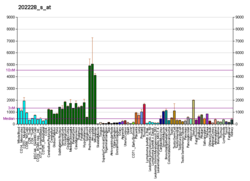| NPTN |
|---|
|
| Identifiers |
|---|
| Aliases | NPTN, GP55, GP65, SDFR1, SDR1, np55, np65, neuroplastin |
|---|
| External IDs | OMIM: 612820; MGI: 108077; HomoloGene: 7531; GeneCards: NPTN; OMA:NPTN - orthologs |
|---|
| Gene location (Human) |
|---|
 | | Chr. | Chromosome 15 (human)[1] |
|---|
| | Band | 15q24.1 | Start | 73,560,014 bp[1] |
|---|
| End | 73,634,134 bp[1] |
|---|
|
| Gene location (Mouse) |
|---|
 | | Chr. | Chromosome 9 (mouse)[2] |
|---|
| | Band | 9|9 B | Start | 58,582,240 bp[2] |
|---|
| End | 58,657,955 bp[2] |
|---|
|
| RNA expression pattern |
|---|
| Bgee | | Human | Mouse (ortholog) |
|---|
| Top expressed in | - Brodmann area 23
- lateral nuclear group of thalamus
- cerebellar vermis
- germinal epithelium
- jejunal mucosa
- tail of epididymis
- bronchial epithelial cell
- visceral pleura
- orbitofrontal cortex
- caput epididymis
|
| | Top expressed in | - nucleus accumbens
- superior frontal gyrus
- cerebellar cortex
- olfactory tubercle
- lobe of cerebellum
- primary visual cortex
- cerebellar vermis
- cingulate gyrus
- lateral geniculate nucleus
- prefrontal cortex
|
| | More reference expression data |
|
|---|
| BioGPS |  | | More reference expression data |
|
|---|
|
| Gene ontology |
|---|
| Molecular function | - transmembrane transporter binding
- fibroblast growth factor receptor binding
- cell adhesion molecule binding
- type 1 fibroblast growth factor receptor binding
- cell-cell adhesion mediator activity
- protein binding
| | Cellular component | - integral component of membrane
- synaptic membrane
- membrane
- postsynaptic density
- plasma membrane
- inhibitory synapse
- dendrite
- presynaptic membrane
- cell surface
- axon
- Schaffer collateral - CA1 synapse
- glutamatergic synapse
- GABA-ergic synapse
- integral component of presynaptic active zone membrane
- integral component of postsynaptic density membrane
- immunological synapse
| | Biological process | - visual learning
- positive regulation of long-term synaptic potentiation
- nervous system development
- cell adhesion
- positive regulation of protein localization
- positive regulation of ERK1 and ERK2 cascade
- positive regulation of long-term neuronal synaptic plasticity
- positive regulation of neuron projection development
- positive regulation of cytosolic calcium ion concentration
- homophilic cell adhesion via plasma membrane adhesion molecules
- modulation of chemical synaptic transmission
- synapse organization
- regulation of receptor localization to synapse
- excitatory synapse assembly
- positive regulation of protein phosphorylation
- positive regulation of fibroblast growth factor receptor signaling pathway
- long-term potentiation
- axon guidance
- dendrite self-avoidance
- trans-synaptic signaling by trans-synaptic complex, modulating synaptic transmission
- negative regulation of cytokine production
- cellular calcium ion homeostasis
| | Sources:Amigo / QuickGO |
|
| Orthologs |
|---|
| Species | Human | Mouse |
|---|
| Entrez | | |
|---|
| Ensembl | | |
|---|
| UniProt | | |
|---|
| RefSeq (mRNA) | |
|---|
NM_001161363
NM_001161364
NM_012428
NM_017455 |
| |
|---|
NM_001293673
NM_009145
NM_001357751 |
|
|---|
| RefSeq (protein) | |
|---|
NP_001154835
NP_001154836
NP_036560
NP_059429 |
| |
|---|
NP_001280602
NP_033171
NP_001344680
NP_001392991 |
|
|---|
| Location (UCSC) | Chr 15: 73.56 – 73.63 Mb | Chr 9: 58.58 – 58.66 Mb |
|---|
| PubMed search | [3] | [4] |
|---|
|
| Wikidata |
| View/Edit Human | View/Edit Mouse |
|


















